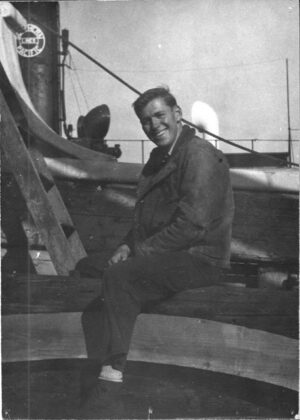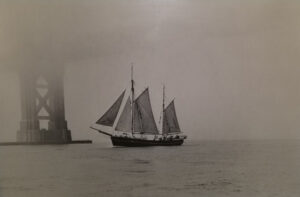Kelly House Sunday Afternoon: Norman de Vall, Voyage of the Fri
A Collector’s Tale
As soon as I got my first boat at age12 or 13, I found in the back waters of Los Angeles Harbor a scrapped steam schooner that had been reduced to a hollow shell stripped of anything metal or polished wood. I was fascinated thinking of the lives of the men who sailed her. But my collection of nautical memorabilia really began at age 14, when I was given the heavy brass Chelsea 24 hour clock, now being exhibited as part of the Kelley House Museum’s Wind & Water exhibit.
Five years later in 1958 I was a cadet at the California Maritime Academy surrounded by maritime history, manner, vocabulary and expectation. Soon thereafter, I was a deckhand on the Oakland Estuary restoring the State Historical Ship fleet. For three years I worked aboard these old ships, including WAPAMA, C.A. THAYER, EUREKA, BERKELEY, SAN LEANDRO, HERCULES and ALMA. This was followed by joining the Seaman’s Union of the Pacific and the Inland Boatman’s Union working on tugs to dock ships into their berths. Much of what is in the exhibit was originally pulled from the debris bins on the piers.
Sailing on the weekends didn’t add much to the collection, but sailing eventually led me to the stevedore industry. By age 23 I was hired as a “stevedore superintendent.” My shifts for Matson Terminals supervised the work of as many as 200 longshoremen a night. Again the debris boxes and bins held collectibles.

Norman de Vall aboard the WAPAMA while working on the Beaches and Parks Historic Ships Project in 1959-1961. Ferry in background would be either the EUREKA, BERKELEY or SAN LEANDRO.
Along the way, the U. C. Berkeley Main Library accidently threw out 90 percent of the Bancroft’s map archive. By chance I knew who had emptied the garbage cans, having driven through Sather Gate at just the right moment, and eventually I was able to return most of those lost. The Bancroft expressed their appreciation by allowing me to keep some that were duplicates plus gifting to me the Panama Pacific medallion commemorating the opening of the canal.
By now my dream was to “build or buy a sailing cargo ship.” Stevedoring enabled me to share the lives of longshoremen, crew members, masters, mates and pilots, but few had actually sailed. Those who had inspired something anew. Again, by good chance, I was asked to survey vessels in Iceland and Norway on my way to study stevedoring at the London School of Economics. En route, I came upon small sailing cargo ships, still able to carry out their reason for being, and so I initiated the FRI Project, which was to become “The last sailing cargo ship from North Europe to San Francisco.”
The Sailing Vessel (SV) FRI (pronounced “free”) was the last of many that might have so served, but FRI, laying in Aalborg, Denmark, had no match. She was by far the most ready to return to the open ocean. I obtained a 30-day option at .01percent of her sale price (or $80). I then reached out to friends and family for the rest. One month later we owned a ship, nine months later we sailed from Copenhagen for Scotland, and five months later sailed through the Golden Gate into San Francisco.
After her oceanic crossing, FRI went on under a different owner to protest the French nuclear tests in the western Pacific. I returned to Mendocino as an “owner builder” and, as a concerned citizen, eventually was elected to the Board of Supervisors to represent Mendocino’s Fifth District from 1979-1995.
Life has changed but I consider myself more a mariner than a land person. At sea, there are no guarantees of First Responders.
About the Kelley House
The Kelley House Museum is an ocean-view house museum in the heart of the historic district of Mendocino, California. Its mission is to collect, preserve, protect and share the rich history of the Mendocino Coast. It houses the only museum-quality storage and research facility open to visitors on the Mendocino California Coast.





